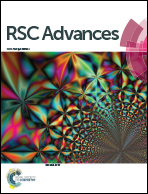Abstract
A monolayer of redox-active copper–polypyridyl complexes was prepared on glass and silicon substrates. The monolayer was characterized in detail by a combination of complementary surface analysis techniques. The immobilized complex was utilized for catalytic oxidation of ascorbic acid. The surface bound catalyst was found to be temporally and thermally stable, efficient, as well as partially recyclable. It also showed marked improvement over the performance of the same complex under homogeneous conditions, in terms of the catalytic activity and turnover numbers. Such supported catalyst systems are drawing significant attention as they enable merging of the virtues of homogeneous and heterogeneous catalysis.


 Please wait while we load your content...
Please wait while we load your content...